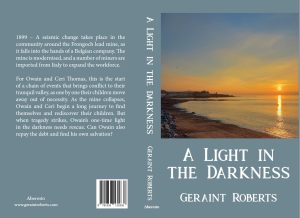
After a long wait (mainly caused by a Masters degree taking up all my thoughts), I am in the throes of releasing ‘A Light in the Darkness’, a new novel. It is the final chapter of the mining trilogy, involving Owain Thomas and his family.
Taking up the story from 1899, Owain recants his fortunes, together with that of his wife, Ceri and children. It charts the demise of the Frongoch lead mine and the aftermath. The back story is as historically accurate as can be made from the remaining accounts of the time. The blurb reads:
1899 – A seismic change takes place in the community around the Frongoch lead mine, as it falls into the hands of a Belgian company. The mine is modernised, and a number of miners are imported from Italy to expand the workforce.
For Owain and Ceri Thomas, this is the start of a chain of events that brings conflict to their tranquil valley, as one by one their children move away out of necessity. As the mine collapses, Owain and Ceri begin a long journey to find themselves and rediscover their children. But when tragedy strikes, Owain’s one-time light in the darkness needs rescue. Can Owain also repay the debt and find his own salvation?
The novel continues the theme of a fictional personalised journey through the history of the area. Frongoch went through a seismic change. The remnants of the Cornish influence in mining in Ceredigion had been decreasing, with emigration and the decline of the industry. Frongoch was sold by its owner, who was an old man – his sons not following in the family business.
In their place, a Belgian company bought the mine. They had grand designs to own the whole process of lead and zinc mining from source to end product. What they failed to anticipate was the lack of experienced workforce remaining in the area. To solve this issue, a group of lead miners were brought in from newly independent Italy.
The men of Lombardy and Bergamo were initially welcomed, but the relationship soured, poisoned by poor management, in spite of the efforts of one man.
Owain and Ceri persevere through this time, until they are forced to move. The relocation also stokes Ceri’s dreams of reuniting with her children, who for various reasons have left the fold.
The cover shows a sunset at Aberystwyth, reflecting on the tale being the twilight of Owain’s life. It also has direct relevance to one particular scene, later in the book. (Before the keen-sighted say – yes, I know the pier is not as long as it would have been at the time! However, I did remove the war memorial, Blaenplwyf mast and a paddle boarder from the image.)
As the story runs parallel to Dafydd’s tale, there are one or two scenes that appear in his story, albeit written slightly differently – to reflect that people remember things in marginally different ways. Dafydd’s tale ended in 1920, but there is scope for a third book there, to bring his cycle to a conclusion. It’s on the cards at some point!
The book is in the end point of the printing process and should be out very soon. More to follow on that, plus a few posts about key moments in the background history.